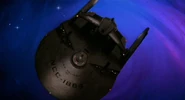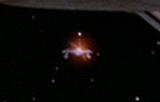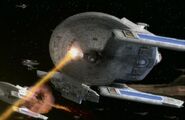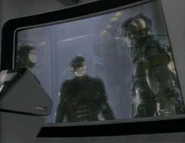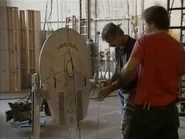The Miranda-class starship was a type of starship introduced by Starfleet in the late 23rd century and remained in use through the late 24th century.
History
Miranda-class starships were in service as early as the mid-2280s. (Star Trek II: The Wrath of Khan; Star Trek IV: The Voyage Home)
Some Miranda-class starships constructed during the first half of the 24th century fell under the authority of the Yoyodyne Division, around stardate 22519.5. Vessels including USS Brattain were constructed at this time at 40 Eridani A Starfleet Construction Yards. (TNG: "Night Terrors" dedication plaque)
The mission profile of the Miranda-class varied from performing various scientific roles to conducting patrol duties. (Star Trek II: The Wrath of Khan; TNG: "Night Terrors"; Star Trek IV: The Voyage Home; DS9: "In the Cards") By the latter half of the 24th century, one variation of this class was known by the designation of Class 6 Federation supply ship. (TNG: "Unnatural Selection")
The Miranda-class was present in several major Federation engagements against the Borg, including the Battle of Wolf 359 and the Battle of Sector 001. (DS9: "Emissary"; Star Trek: First Contact) They were also present in numerous Dominion War battles, where they often served as escorts. Many ships of the class saw action during Operation Return, the First and Second Battles of Chin'toka, and the Battle of Cardassia. Many Miranda-class vessels were stationed near Deep Space 9. (DS9: "Sacrifice of Angels", "Tears of the Prophets", "The Changing Face of Evil", "What You Leave Behind", etc.)
Miranda-class starship were also shown as models on several occasions such as in Deep Space 9's classroom. (DS9: "The Nagus")
Technical data
Physical arrangement

The master systems display schematics
The configuration of the Miranda-class shared a similar design lineage and features with the refit Template:ShipClass implemented in the early 2270s. (Star Trek: The Motion Picture)
The Miranda-class was composed of a single primary hull, consisting of a saucer that was similar to that of the Constitution-class; however, the bridge module, positioned on top in the center, was shaped differently than the Constitution-class module.
Mounted on the underside of the primary hull were two nacelle pylons connected to the warp nacelles. (Star Trek II: The Wrath of Khan, etc.)

Forward docking port
Design features of the primary hull included a docking port located on the forward section of the ship; the aft section included two shuttlebays, separated by the vessel's impulse engines. These shuttlebays were visually numbered; "1" being on the rear-port side, and "2" on the rear-starboard side. (Star Trek II: The Wrath of Khan; DS9: "The Way of the Warrior", etc.)
Refits
The Miranda-class could be fitted differently depending on the mission. There were four different known configurations utilized with the Miranda during its time in service.
The predominant Miranda-class design included a superstructure (or "roll bar") fitted immediately above the primary hull, as a dorsal extension of the ventral nacelle pylons. This superstructure was equipped with torpedo launchers and phaser banks. (Star Trek II: The Wrath of Khan, etc.) By late 2373, this predominant design would undergo an upgrade to its warp nacelles. (DS9: "Sacrifice of Angels")
Some refits lacked the addition of a superstructure, and in other cases, included two large pods affixed on the port and starboard sides of the primary hull. (TNG: "Unnatural Selection"; DS9: "Emissary")
An additional refit of the Miranda-class was also created and configured with much more significant modifications. This design, known as the Template:ShipClass, was retired during the 2280s. (TNG: "Cause and Effect")
Tactical systems
Standard to all designs were six dual phaser banks located on the primary hull – three mounted to the top and three mounted on the bottom of the saucer.
In those ships possessing the "roll bar," that superstructure contained two tubular phaser emitters on each side that could fire both forward and to the ship's flanks. There were also two forward and two aft photon torpedo launchers housed in a pod mounted in the center of the superstructure. (Star Trek II: The Wrath of Khan, Star Trek: First Contact)
By the 24th century a number of modifications were made to the Miranda-class weapons systems. Some Miranda-class vessels, such as those of the "twin-pod" variant, included an upgraded phaser array mounted on the lower part of the ventral dome and photon torpedo launchers in the main part of the ship rather than in a pod on the "roll-bar". (DS9: "Emissary")
The class 6 variant of this class featured class 3 defensive armaments. (TNG: "Unnatural Selection")
A majority of 24th century Miranda-class vessels of the "roll-bar" variant, particularly during the Dominion War, were equipped with phaser arrays and photon torpedoes equivalent to those used on other ships of the era, while keeping the same weapon array placements as the 23rd century Miranda. (DS9: "Sacrifice of Angels", "What You Leave Behind", VOY: "Endgame", etc.)
Interior design
Main bridge
The design of Miranda-class bridge during the 23rd century shared a similar layout to contemporary vessels of that era.
Located on Deck 1 of the saucer section, the Main Bridge housed the command center of the Miranda-class. The design lineage of the main bridge was a fairly standard floor plan for a Federation starship. Against the forward bulkhead was placed the ship's viewscreen, with side-by-side navigation and helm consoles. The captain's chair was directly aft of the aforementioned stations. Several variations exist in the layout of the surrounding stations.
At the rear and center of the USS Reliant's bridge was the turbolift entryway. The primary stations, which were located along the rear of the bridge, included the tactical station on the port side of the bridge. Along the rear starboard side of the bridge were the primary science station and communications station. (Star Trek II: The Wrath of Khan) The bridge similarly found on board the USS Saratoga (NCC-1887) also had primary stations located along the perimeter of the bridge; however, the Saratoga's bridge included the science station on the port side of the bridge, nearly parallel to the navigation station. (Star Trek IV: The Voyage Home)
By the 24th century, further reconfigurations were made to the layout of the bridge, including the separation of the navigation and helm station, which was replaced by the conn station (on the starboard side) and ops station (on the port side).
The bridge of the USS Lantree was relatively simplistic in design, containing little more than a large LCARS interface and star charts on the back of the bridge. (TNG: "Unnatural Selection") The bridge of the USS Saratoga (NCC-31911) had a much more complex layout, including two additional standing consoles located behind the conn and ops, parallel and slightly behind the captain's chair. The standing console on the port side of the ship contained the tactical station. Also located on the port side, in the foremost section of the bridge, was a turbolift. Along the aft of the bridge were several various access stations. (DS9: "Emissary")
Relatively similar to the bridge of the Saratoga, the bridge of the USS Brattain had large support braces surrounding the captain's chair to the sides and rear. In place of the two standing consoles of the Saratoga was a single engineering station, placed directly behind the captain's chair and directly in front of an engineering MSD interface. (TNG: "Night Terrors")
Corridors
USS Reliant corridor |
The numerous corridors that connected the various sections of the Miranda-class resembled those of contemporary designs. The corridors on board the USS Reliant resembled those of the refit Constitution-class. (Star Trek II: The Wrath of Khan) The outer corridors on board the USS Saratoga (NCC-31911) were heavily fortified with a system of support braces. (DS9: "Emissary")
Main engineering

Main engineering, USS Reliant
Main engineering contained a vertical warp core, with multiple levels surrounding the core. (Star Trek II: The Wrath of Khan)
Transporter room

Transporter room, USS Reliant
The staging area of the transporter room on board the Miranda-class possessed six transporter pads. Transporter control could be accessed through a console located on the bridge. (Star Trek II: The Wrath of Khan)
Shuttlebay
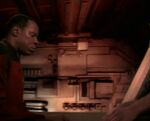
Miranda-class shuttle bay interior
The Miranda-class features two shuttlebays, located port and starboard of the ship's center. On some Miranda-class ships, such as the USS Saratoga, both of the shuttlebays hold escape pods capable of transporting several personnel. (DS9: "Emissary")
Crew quarters

Crew quarters, USS Saratoga (NCC-31911)
The crew quarters located on the outer rim of the ship contained several large picture windows, littered with numerous large support braces. (DS9: "Emissary")
Ships commissioned
- Named
- USS Brattain (NCC-21166)
- USS Lantree (NCC-1837)
- USS Majestic (NCC-31060)
- USS Nautilus (NCC-31910)
- USS Reliant (NCC-1864)
- USS Saratoga (NCC-1887)
- USS Saratoga (NCC-31911)
- USS ShirKahr (NCC-31905)
- USS Sitak (NCC-32591)
- USS Tian An Men (NCC-21832)
- USS Trial (NCC-1948)
- Unnamed
Appendices
Appearances
- Star Trek films:
- TNG:
- DS9:
- "Emissary"
- "The Nagus" (model)
- "Battle Lines" (model)
- "Dramatis Personae" (model)
- "Duet" (model)
- "The Way of the Warrior"
- "By Inferno's Light"
- "Call to Arms"
- "A Time to Stand"
- "Sons and Daughters"
- "Behind the Lines"
- "Favor the Bold"
- "Sacrifice of Angels"
- "You Are Cordially Invited"
- "The Magnificent Ferengi"
- "The Reckoning"
- "Tears of the Prophets"
- "Afterimage"
- "Treachery, Faith and the Great River"
- "Strange Bedfellows"
- "The Changing Face of Evil"
- "Tacking Into the Wind"
- "What You Leave Behind"
- VOY: "Endgame"
Background
Name
The name Miranda-class was not mentioned in dialog on-screen, but was devised by the art department of TNG to refer to this design. The name was used on several pieces of on-screen signage referring to these vessels, and is also used by dedicated references such as the Star Trek Encyclopedia.
According to the Encyclopedia, the class was "named for Prospero's daughter, a character in William Shakespeare's last play, The Tempest."
According to an early final draft of the script for "Unnatural Selection" the USS Lantree was identified as a "class R Starfleet supply ship" rather than a "class 6 Federation supply ship". [1]
Specifications
The specifications for the Miranda were not mentioned in dialog, but are referenced from the show's art department. The initial length for the Miranda-class of 765' (233m) was established during the production of Star Trek II, that was later followed up by Andrew Probert during TNG Season 1. The exact length, based on the universally accepted length of the refit Template:ShipClass, at least behind-the-scenes, at 1000 feet and assuming that both classes employ standardized ship components like nacelles and saucers-sections, is 234.9 m (770.67ft). The scale of the CGI mesh was scaled approximately twenty-five percent smaller than had been previously established. According to a 20 January 1998 post in the newsgroup alt.tv.star-trek.ds9 by David Stipes, a length of approximately 500' to 560' (167m to 187m) was used when he blocked shots in DS9. [2]
Studio model
In the earliest scripts of Star Trek II: The Wrath of Khan the USS Reliant was supposed to be a Template:ShipClass. However, the cumbersomeness of the TMP-studio model (vehemently expressed by director of photography Kenneth Ralston at the time) was part of the reasons why the class of the Reliant was redesigned from a Constitution-class to the Miranda-class, the other reason being that the producers were afraid that audiences would not be able to tell the two ships apart during the battle sequences. "In the dogfight you had to instantly recognize which ship you were looking at, so they had to look different. At the same time, you had to make them look like they came from the same culture and had the same technology", Joe Jennings elaborated.(Star Trek: The Magazine Volume 3, Issue 3, page 69)
Design

The original designs as sent to Harve Bennett
The script called for an older cruiser of "Enterprise's own class" but of a "different configuration." This ended up being a different class of starship in its own right, the first distinct Federation starship design other than the NCC-1701 to ever appear in a filmed, live-action Star Trek production. What was to become the Miranda-class studio model, specifically the USS Reliant, was designed at Paramount by Joe Jennings, Mike Minor and Lee Cole. On the design Jennings noted,"It was the first time a new spaceship had been designed since the Klingon battle cruiser. That was a lot of fun. She was supposed to be a coastal and geodetic survey ship, like a buoy tender. She would be armed perhaps, but only lightly; she wasn't a lion ship like the Enterprise. Also, remember, the Enterprise was supposed to be an exploratory vessel, where the armament was secondary. That was even more true for the Reliant; she was supposed to just stick around in the known universe and take care of things that everybody already knew about.(...)It was fun to try to make it look identifiable different; we had long postulated that the circular saucer said "This is Starfleet Navy," and it uses engines that looked pretty much like those on the Enterprise."(Star Trek: The Magazine Volume 3, Issue 3, page 69-70)
The Miranda-class model was originally designed "upside-down", with the nacelles above the dish and the "roll-bar" below the dish. However, when the initial drawing was sent to Harve Bennett for approval, he viewed the drawings upside down. He liked the design and signed off on it. The FX team debated whether or not to send the sketches back to Bennett (who was in Israel at the time working on another project) with the correct orientation, but they decided that there was insufficient time to do so and decided to add a "rollbar" to balance out the suddenly dropped nacelles.
Large studio model
The studio model was constructed at Industrial Light & Magic (ILM) under supervising model maker Steve Gawley. Among Gawley's crew were model makers Bill George, Sean Casey, Larry Tan, Jeff Mann, Steve Sanders, Brian Chin, Bob Diepenbrock, and Mike Fulmer, with Martin Brenneis responsible for model electronics.
In constructing the model, ILM took much consideration in creating a model that could be light enough to be easily manouvered during photography. This approach was taken because they did not want to create another bulky model, like the Enterprise built for Star Trek: The Motion Picture. As a result, the Reliant model was made at scale three-quarters that of the Enterprise. In addition, the hull for the Reliant was shaped from vacuum-formed plastic, resulting in a model that was light enough that two people could handle it. The model's interior wiring was also much simpler than was used in the Enterprise model, limited only to what was required of it as written in the script. The interior contained a metal armature that allowed it to be mounted in various positions as required for filming. The roll bar was a removable piece. A heavily modified duplicate was constructed to showcase the battle damage for later scenes in the movie.
Enlarged pieces were constructed for close-up shots, notably the roll bar. Explosive charges and pre-packed pieces of plastic scrap were packed into the casts to give the illusion of an exploding ship. The exploded model was formed from wax to allow the pieces to be re-molded for additional shots. (The Making of Star Trek II: The Wrath of Khan) Other pieces that were constructed in a similar fashion were a port nacelle and a section of the aft deck were the impulse deflector crystal was located (These pieces are featured in the Inside the Star Trek Archives special of TNG Season 2 DVD).
The high quality large scale studio model continued to be reused for over fifteen years by the producers of TNG and DS9 to represent a variety of different starships and classes, following modifications used in creating the USS Saratoga NCC-1887, USS Lantree, the USS Brattain , the USS Bozeman and the USS Saratoga NCC-31911. After "Emissary", the model was put back together in its original configuration and used one last time in Star Trek Generations without having its Brattain markings on the roll bar and its Saratoga-markings on the saucer changed, as an unnamed ship.
This model was sold as Lot #985 on 7 October 2006, "USS RELIANT MODEL", estimated at $7,000-$9,000: A large 63x37 inch model, labeled as both the USS Saratoga (on the main body) and USS Brattain (on the "roll bar"). Auction price: $50,000 US ($60,000 US with premium). The winner eventually sought out Ed Miarecki's help in restoring the model in a pristine condition.[3]
Small studio models
ILM's small studio model Preparing a break-away model of the USS Saratoga for destruction |
Apart from the high quality large scale model the same ILM-team also built a smaller battle damaged version for forced perspective shots in the movie (the second encounter with the Enterprise in the Mutara Nebula). Built partly from an AMT/Ertl Enterprise model kit S970 and custom made vacuum-formed pieces, it was the only time that this model was used for filming purposes.
This model was eventually sold as Lot #984 on 7 October 2006,"SMALL BATTLE-DAMAGED U.S.S. RELIANT MINATURE MODEL", estimated at $6,000-$8,000: A small 17x10x4 inch model of the Reliant, built for Star Trek II by ILM, that came with a studio blueprint depicting the early concept for Reliant in its original "upside down" configuration. Auction price: $24,000 ($28,800 with premium). The winner, a man from London is featured in The History Channel's documentary Star Trek: Beyond the Final Frontier.
Three so-called break-away models of the class, cast from the molds taken off the studio model, representing the USS Saratoga were built for the DS9 premiere "Emissary". All three of them were blown up to represent the destruction of the Saratoga. (Movie Magic Season 1, Episode 11: Models and Miniatures: A Model of Perfection)

USS Trial docking at Deep Space 9
Another physical model was constructed representing the USS Trial appearing in "The Way of the Warrior" This was a modified AMT/Ertl model kit No. 8766 of the USS Reliant. The origin of the name is a result of the rearrangement of the letters R-E-L-I-A-N-T to get T-R-I-A-L (minus the E-N). The registry was also conceived the same way, rearranging 1-8-6-4 to get 1-9-4-8.[4] Additional model kits were used for the closing fleet shots in "Call to Arms", footage of which, shot for that episode, would be used for consecutive episodes as stock footage.[5]
Yet another AMT model was slated to make an appearance, along with other models of varying starship classes, as one of the golden models in the display cases in the observation lounge of the USS Enterprise-E in Star Trek Nemesis. John Eaves built the model, filled it with resin, had it gold plated at ArtCraft Plating, but failed to deliver the model in time for shooting and it was subsequently never used. Eaves retained the model, "I got the other ships done in about a week and took them to the stage and he [John Dwyer] had already filled the cases twice with doubles of the original 6. It was too much work to take out and replace the dups with the new so they didn’t make it on the big screen, but they did wind up at my house again.", Eaves recalled.[6]
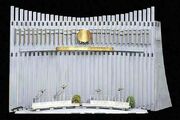
Starfleet Headquarters model with a Miranda-class vessel 2nd from the right.
Another commercial product was used as one of the four models mounted in front of the sail shaped top half facade of Starfleet Headquarters on the Presidio, appearing in DS9: "Homefront", "Paradise Lost". The top half of the facade was itself a studio model and the starship models were Galoob Micro Machines (most likely taken from the pewter painted "Star Trek Television Series I Box Set" and "Star Trek the Movies Collectors Edition"). (Star Trek: The Magazine Volume 1, Issue 13, p. 112) A Miranda-class vessels was mounted 2nd from the right.
CGI model
Even as the original models were worn out, a new CGI model was created. A low resolution CGI-model, built at ILM by Larry Tan and Paul Theren, made its first appearance as a deep background model in Star Trek: First Contact. According to DS9 Visual Effects Coordinator David Stipes, the Miranda-class ships appearing in the later seasons of DS9 and VOY were modelled, surfaced, and animated by Digital Muse [7], debuting in DS9: "Favor the Bold". Since ILM was requested by Paramount Pictures to hand over their CGI-models of the Template:ShipClass, Template:ShipClass, Template:ShipClass and Template:ShipClass, also featured in First Contact, for remodeling and remapping for the earlier episode "Call to Arms", it stands to reason that Stipes referred to the CGI-model of the Miranda-class ILM built, something Muse's supervisor Bruce Branit more or less confirmed (Cinefantastique, Vol.30, No.9/10, page 64). But like the others it was built at a fairly low resolution and had to be partially rebuilt and remapped.
Legacy
Several Miranda-class related items were sold in various auctions, including:
- A Christie's 40 Years of Star Trek: The Collection auction Lot #726, "STARSHIP RELIANT MODEL BLUEPRINTS AND STAR TREK II: THE WRATH OF KHAN DEVELOPMENT DOCUMENTS", estimate $800-$1,200: Which included a collection of blueprints used in developing the Starship Reliant miniature for Star Trek II. Auction price: $4,000 US ($4,800 US with premium), sold on 7 October 2006.
- A It's A Wrap! sale and auction which was described as "BRONZED STARSHIP MODEL". This Miranda-class derived model had four nacelles, with the standard nacelles under the ship along with two others attached to the roll-bar above the other nacelles. This configuration was never shown on screen. Final auction price: $232.50 US. [8]
- A It's A Wrap! sale and auction where an unsold foam core camera test model was also listed.[9]
For the 2008 remastering of TOS: "The Ultimate Computer", the production crew of David Rossi, Denise Okuda and Mike Okuda briefly considered using alternate ship types to represent the fleet that engaged the M-5 computer. According to M. Okuda, "one of the ideas we considered was to have a Reliant-type configuration for a couple of the guest ships. The problem with a smaller ship is that you don't want the sense that the Enterprise is more powerful, because that would hurt the drama of the story. Ultimately, keeping all four ships the same emphasizes that the only variable is that the Enterprise is piloted by the M-5 computer." Another factor in maintaining the integrity of the original designs, according to D. Okuda, was that "we all decided that it was best to honor the expectations of fans who had grown up seeing four Constitution-class ships." [10]
Technical Manual
The following information of specifications and defenses comes exclusively from the Star Trek: Deep Space Nine Technical Manual:
- Production Base: ASDB Integration Facility, Starbase 134 Integration Facility, Rigel VI.
- Type: Medium Cruiser.
- Accommodation: 220 officers and crew; 500 personal evacuation limit.
- Power Plant: One 1500 plus Cochrane warp core feeding two nacelles; one impulse system.
- Dimensions: Length, 277.76 meters; beam, 173.98 meters; height: 65.23 meters.
- Mass: 655,000 metric tonnes.
- Performance: Warp 9.2 for 12 hours.
- Armament: Six type-7 phaser emitters; two pulse phaser cannons; two photon torpedo launchers.
Apocrypha
In the comic book Who Killed Captain Kirk? and in the materials published by FASA for use with their Star Trek: The Role Playing Game and Starship Tactical Combat Simulator this ship is referred to as the Reliant-class. FASA describes it as a refit of the Anton-class, which had a similar design that featured TOS-styled warp nacelles.
Apocryphal appearances
- The Interplay PC Game Starfleet Academy features several Miranda-class vessels including USS Oberon (NCC-1806), USS Rutherford (NCC-1835), USS Alexandria (NCC-1842), USS Tempest (NCC-1852), USS Atlantis (NCC-1865), and USS Demeter (NCC-1868).
- The Interplay PC Game New Worlds features the Miranda-class vessel USS Ranger (NCC-1975).
- The Activision PC Game The Fallen features the Miranda-class vessel USS Ulysses (NCC-10767).
- The Interplay/Taldren games Starfleet Command I, Starfleet Command II and its expansion, Orion Pirates all based the Federation light cruiser hulls on the Miranda-class.
- In Cryptic Studios' MMORPG Star Trek Online, one of the first ships a Federation character receives is a Miranda class.
External link
- Template:NCwiki

